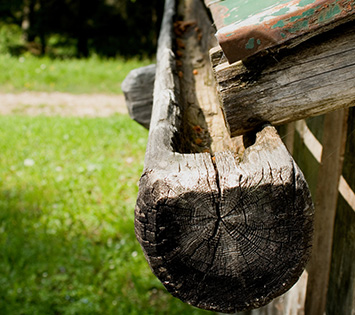A Brief History of Rain Gutters
March 18, 2016
Are you interested in keeping your rain gutters clean of debris? Then, it is very likely that you might be wondering how rain gutters came to be and when they originated. Believe it or not, rain gutters have a long and storied existence that covers several millennia. As a matter of fact, there's a surprisingly fascinating history behind the rain gutter – one that dates back thousands of years. Today's blog post is all about a brief history of
rain gutters, depicting the formation, evolution, and modernization of this valuable tool.
 Between 3000 BC and 1500 BC:
Between 3000 BC and 1500 BC: The Harappan civilization uses toilets linked by drains. This is the first form of gutter on record.
Between 27 BC and 14 AD: The Romans reinvent road-building, allowing water and mud to run downhill and into gutters.
47 AD: Romans bring gutters to Great Britain.
1066: After the Norman invasion, residences, churches and other structures were rebuilt with parapets and stone roofs. This leads to rain gutters that have gargoyles, which are used to "spit" water away from the building.
1240: A downspout is erected on the Tower of London to protect its whitewashed walls. It's supposed to be the first downspout ever built in Great Britain.
Between 1300 and 1500: After the end of the Middle Ages, local authorities in British communities with limited resources officiate over a range of rain gutters.
Between 1536 and 1541: The dissolution of the convents, monasteries, friaries, and priories leads to a plethora of lead being available. As a consequence, there is a spike in the industry for hopper heads, decorative cisterns, rain gutters, and other rainwater supplies.
1709: Cast iron replaces lead as the most popular rain gutter material!
 Between 1710 and 1750:
Between 1710 and 1750: Rain gutters become very popular on buildings and houses in the American colonies. The most common ones consist of two wooden boards in a V-shape and that are fastened with wooden pins.
Between 1751 and 1800: Built-in rain gutters become common on new buildings in the U.S. They tend to be made of wood and are V-shaped.
Between 1801 and 1825: Cast iron downspouts are incorporated into more complex and taller buildings in America. Amazingly, they let runoff water be channeled almost imperceptibly into underwater drainage systems.
Between 1900 and 1925: Metal rolling machines are invented and become highly popular in America, enabling builders to roll half-round steel rain gutters that are placed on the edges of houses and buildings.
Between 1939 and 1950: After World War II, plastic is the material of choice for many rain gutters in Britain.
Between 1960 and 1965: Seamless aluminum rain gutter machines were introduced, which dramatically altered the way rain gutters were produced. About 70% of rain gutters in the U.S. are made of aluminum today due to its strength and weight.
 Between 1970 and 1978:
Between 1970 and 1978: Portable rain gutter machines are launched so that rain gutters can be easily transported on a trailer and installed at a construction site.
1979: Bob DeMartini, MIT graduate, starts working on an innovative rain gutter protection system. The system is issued two years later.
Modern day: Hundreds of satisfied Rain Gutters Solution customers across South Florida never have to worry about cleaning their rain gutters again.
As you can see, rain gutters have come a long way. For any questions or inquiries, you can always contact us. We provide unparalleled repairing, unclogging, and cleaning services to make your rain gutters last longer. With over twenty years of experience in South Florida's custom rain gutter business, we are sure to meet all your rain gutter needs. Fill out the form below to schedule your next repair today!
 Between 3000 BC and 1500 BC: The Harappan civilization uses toilets linked by drains. This is the first form of gutter on record.
Between 3000 BC and 1500 BC: The Harappan civilization uses toilets linked by drains. This is the first form of gutter on record. Between 1710 and 1750: Rain gutters become very popular on buildings and houses in the American colonies. The most common ones consist of two wooden boards in a V-shape and that are fastened with wooden pins.
Between 1710 and 1750: Rain gutters become very popular on buildings and houses in the American colonies. The most common ones consist of two wooden boards in a V-shape and that are fastened with wooden pins. Between 1970 and 1978: Portable rain gutter machines are launched so that rain gutters can be easily transported on a trailer and installed at a construction site.
Between 1970 and 1978: Portable rain gutter machines are launched so that rain gutters can be easily transported on a trailer and installed at a construction site.